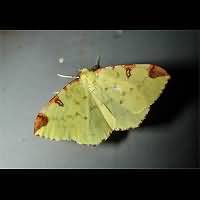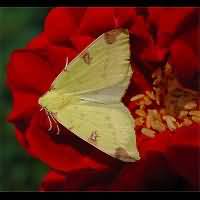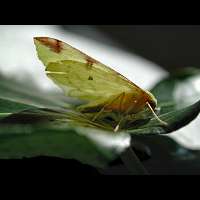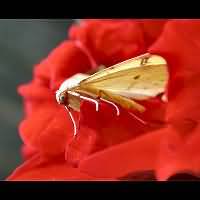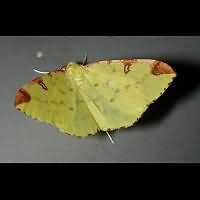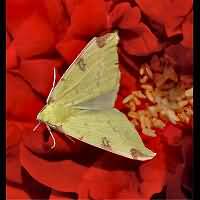Brimstone Moth (Opisthograptis luteolata)
The Brimstone Moth is yellow, just like the Brimstone, and is among the most beautiful of all Geometers. It keeps its wings slightly upwards and by doing so looks like a butterfly even more. Being yellow like that with a few chestnut brown patches there is no other species like it, so identifying it is extremely easy. The wingspan is variable: 28 to 44 mm. Females are bigger than males and animals of the first generation are bigger than those of later generations.
The caterpillar of the Brimstone Moth is greyish or reddish brown, seldom greenish. There is a big bump on the 6th segment. You'll immediately recognise it being a Geometer Worm, but it has 3 pairs of hind legs. This is unique among Geometer Worms, for all the others have two pairs only. The head is light brown with some dark brown markings. The larva will reach a length of some 33 mm. The caterpillars pupate in an extremely dense and strong cocoon on the ground. The cocoon may also be attached by a strong wire just above the ground, or is made in a crack in the bark of a tree or fence or even wall. Usually the Brimstone Moth overwinters like this, but half grown larvae may also overwinter as such. The caterpillar lives on a number of trees and shrubs, but apple, maythorn and hawthorn seem to be most popular.
The Brimstone Moth is on the wing for a long period. The first appear in April and the last are seen in October. It flies in two or even three generations a year in most of Britain. According to some experts it probably flies in three generations over a two year period. In Northern Scotland it is single brooded, on the wing in June and July only. Starts flying in early dusk. Is easily attracted to light and is often seen around lit windows or outside lights. Usually a good model for photographers as it is not easily disturbed during daylight and in some cases might even be handled gently. A very common species in gardens, parks and hedgerows, but also on heaths. Common throughout all of Britain, except for Shetland. Also a very common species in continental Europe.
The Brimstone Moth is yellow, just like the Brimstone, and is among the most beautiful of all Geometers. It keeps its wings slightly upwards and by doing so looks like a butterfly even more. Being yellow like that with a few chestnut brown patches there is no other species like it, so identifying it is extremely easy. The wingspan is variable: 28 to 44 mm. Females are bigger than males and animals of the first generation are bigger than those of later generations.
The caterpillar of the Brimstone Moth is greyish or reddish brown, seldom greenish. There is a big bump on the 6th segment. You'll immediately recognise it being a Geometer Worm, but it has 3 pairs of hind legs. This is unique among Geometer Worms, for all the others have two pairs only. The head is light brown with some dark brown markings. The larva will reach a length of some 33 mm. The caterpillars pupate in an extremely dense and strong cocoon on the ground. The cocoon may also be attached by a strong wire just above the ground, or is made in a crack in the bark of a tree or fence or even wall. Usually the Brimstone Moth overwinters like this, but half grown larvae may also overwinter as such. The caterpillar lives on a number of trees and shrubs, but apple, maythorn and hawthorn seem to be most popular.
The Brimstone Moth is on the wing for a long period. The first appear in April and the last are seen in October. It flies in two or even three generations a year in most of Britain. According to some experts it probably flies in three generations over a two year period. In Northern Scotland it is single brooded, on the wing in June and July only. Starts flying in early dusk. Is easily attracted to light and is often seen around lit windows or outside lights. Usually a good model for photographers as it is not easily disturbed during daylight and in some cases might even be handled gently. A very common species in gardens, parks and hedgerows, but also on heaths. Common throughout all of Britain, except for Shetland. Also a very common species in continental Europe.

